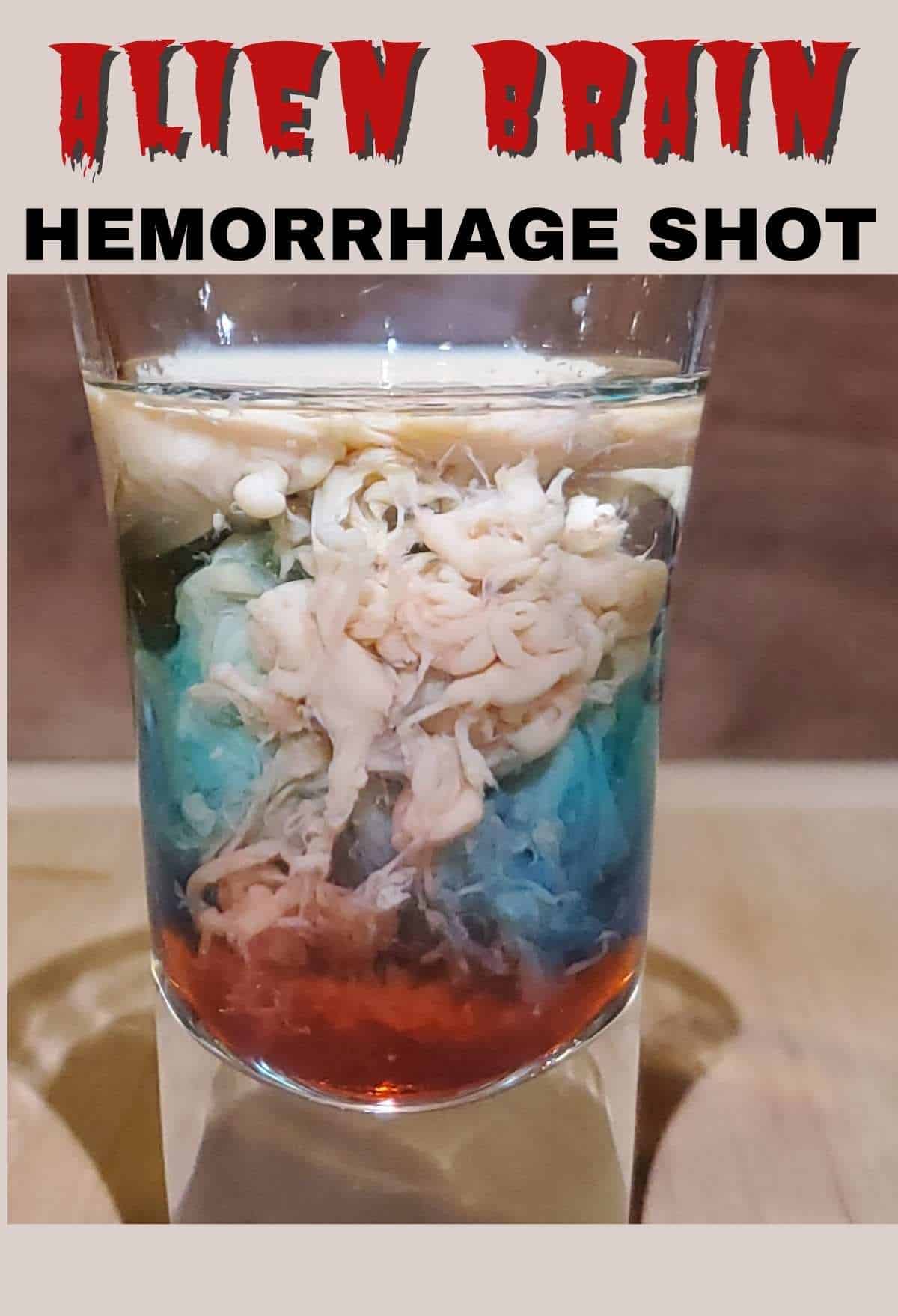Calling all Halloween revelers! Elevate your spooky celebrations with the Alien Brain Hemorrhage Shot, a visually arresting cocktail that’s as captivating as it is delicious. This surprisingly simple concoction boasts a mysterious backstory and offers endless opportunities for creative variations. Prepare to horrify and delight your guests with a drink that will be the talk of your Halloween party—and beyond.
Brewing a Spooky Sensation
The Alien Brain Hemorrhage is a layered cocktail perfect for Halloween, spooky gatherings, or any occasion where a touch of the macabre is desired. This eerie elixir resembles something straight out of a sci-fi horror film, yet its sweet and delightful taste is a pleasant surprise. Learn more about the perfect brats internal temp to complement your spooky feast, or explore the history and significance behind blue willow pattern crockery to complete your themed tablescape.
Concocting the Gruesome Masterpiece
The key to the Alien Brain Hemorrhage lies in the layering, creating the unsettling “brain hemorrhage” illusion. Gather your ingredients and embrace your inner mixologist:
Key Points:
-
Ingredients:
- Grenadine
- Peach Schnapps
- Blue Curaçao
- Bailey’s Irish Cream
-
Layering Technique:
- Pour layers slowly over the back of a spoon to separate the liqueurs.
- Allow each layer to settle before pouring the next.
-
Brain Effect:
- The layered liqueurs create a “brain hemorrhage” effect due to their different densities.
-
Variations:
- Substitute liqueurs for different flavors or colors.
- Add garnishes like gummy worms or maraschino cherries.
-
History:
- Origins unknown, likely emerged in the early 2000s.
- Recently popularized on social media.
-
Perfect for Halloween:
- Gruesome appearance and conversation starter.
-
Enjoyable beyond Halloween:
- Customizable and unique appearance.
| Ingredient | Quantity | Notes |
|---|---|---|
| Grenadine | 1/2 ounce | The “blood” base. |
| Peach Schnapps | 1/2 ounce | Adds sweetness. |
| Blue Curaçao | 1/2 ounce | Creates the alien-like blue hue. |
| Bailey’s Irish Cream | 1/2 ounce | Forms the “brain” matter. |
-
The Bloody Base: Gently pour the grenadine into the bottom of a shot glass, avoiding splashes.
-
A Peachy Keen Layer: Carefully layer the peach schnapps on top of the grenadine, pouring slowly over the back of a spoon.
-
The Alien Glow: Layer the blue curaçao over the peach schnapps using the same spoon technique.
-
The Brainy Finish: Slowly drizzle the Bailey’s Irish Cream over the blue curaçao to form the “brain.”
Pro Tip: Chilling your ingredients and glassware beforehand can improve layering. A drop or two of red food coloring in the grenadine intensifies the gory effect.
Extraterrestrial Twists
The classic recipe is a great starting point, but feel free to experiment. Substituting melon liqueur for peach schnapps offers a different fruity note. Explore various colored liqueurs for a truly alien look. A gummy worm or maraschino cherry “brain” garnish adds to the spooky aesthetic.
Origins of the Alien Concoction
The precise origins of the Alien Brain Hemorrhage shot remain shrouded in mystery. It likely emerged in the early-to-mid 2000s, possibly linked to Halloween festivities. Its recent resurgence in popularity is probably due to social media and the trend of visually striking cocktails.
The Science of the Gore
The layered effect is a simple demonstration of density. Each liqueur has a different density, with grenadine being the densest, sinking to the bottom. The other liqueurs layer on top in ascending order of density, culminating in the lighter Bailey’s.
Beyond Halloween
While a Halloween favorite, the Alien Brain Hemorrhage is versatile enough for any occasion seeking a fun, slightly creepy beverage. Its unique look and customizable nature make it a conversation starter.
Can a Brain Hemorrhage Be Cured? Recovery, Treatment, and Long-Term Outlook
A brain hemorrhage, or brain bleed, is a life-threatening medical emergency requiring immediate intervention. While a “cure” in the traditional sense may not apply, timely treatment can profoundly influence both survival and the extent of long-term recovery.
Recovery from a brain hemorrhage varies significantly depending on several factors, including the location and size of the bleed, as well as the individual’s overall health. Focused rehabilitation plays a crucial role in maximizing functional recovery. Prompt medical attention is paramount. Survival rates and recovery depend on many factors, including the size and location of the bleed.
Some individuals may experience a near-complete recovery and regain most of their abilities. Others may face long-term disabilities, ranging from mild cognitive impairments (like memory problems) to more severe physical limitations, such as paralysis or speech difficulties.
Treatment focuses on stabilizing the patient and controlling the bleeding. This may involve surgery to repair damaged blood vessels or medications to control blood pressure and reduce brain swelling. Supportive care, including ensuring easy breathing and proper hydration, is also critical. After the immediate danger has passed, rehabilitation becomes the focus, involving therapies like physical, occupational, and speech therapy.
Research into brain hemorrhages is ongoing, exploring new treatments and ways to improve recovery. Some research involves less invasive surgical techniques, while others investigate medications that might promote healing. Even research into regenerating damaged brain tissue offers hope.
While complete recovery is possible in some cases, it’s essential to be realistic about the potential for long-term effects. These can vary, from subtle behavioral changes to significant physical challenges. Patients and their families must understand these possibilities and learn about available support resources, including support groups and rehabilitation centers. While we can’t definitively say brain hemorrhages are always “curable,” with prompt medical attention and dedicated rehabilitation, many individuals can make significant progress and lead fulfilling lives.
What is a Craniotomy for Brain Hemorrhage?
A craniotomy, involving the temporary removal of a portion of the skull, is sometimes necessary to treat a brain hemorrhage. This procedure allows surgeons to access the brain, alleviate pressure caused by the bleeding, remove accumulated blood, and potentially repair the source of the bleed. Craniotomy may be necessary for various types of brain hemorrhages, including those caused by trauma, ruptured aneurysms, or arteriovenous malformations (AVMs). Recovery varies depending on the severity and individual health, often involving rehabilitation and ongoing monitoring.
The procedure aims to relieve pressure on the brain by removing accumulated blood and potentially repairing the bleeding source. This may involve clipping a ruptured aneurysm or addressing other causes. After surgery, the removed skull section is replaced and secured. Recovery after a craniotomy can vary considerably depending on factors like the severity of the hemorrhage, its location, and the individual’s overall health.
There are inherent risks with any surgery, including infection, bleeding, stroke, seizures, and complications related to anesthesia. While a major procedure, craniotomy is often life-saving. Sometimes, a less invasive procedure called endovascular coiling may be an option. This involves inserting a catheter to reach the hemorrhage and using coils to block the bleeding. The appropriate treatment depends on the specific situation.
Our understanding of brain hemorrhages and their treatment is constantly evolving. Ongoing research provides new insights into causes, risks, and optimal treatments. While this provides a general overview, a doctor is the best source of personalized information. They can answer questions and guide you on the best course of action.
How to Avoid a Brain Hemorrhage: Lower Your Risk
A brain hemorrhage is a serious medical emergency. It happens when a blood vessel in your brain bursts, leading to bleeding inside or around the brain. This can cause a cascade of problems. While some causes are beyond our control, many risk factors can be managed to reduce the chances of occurrence.
Symptoms: These may include a sudden, severe headache (the “worst headache of your life”), nausea, vomiting, dizziness, seizures, weakness or numbness on one side of the body, speech difficulties, and loss of consciousness. Immediate medical attention is crucial if these symptoms appear.
Preventive Measures:
- Control High Blood Pressure: High blood pressure is a major risk factor. Regular monitoring, medication (if prescribed), a low-sodium diet, and stress management are crucial.
- Manage Cholesterol: High cholesterol contributes to plaque buildup in arteries, making them more vulnerable. A healthy diet, regular exercise, and medication (if necessary) are important for cholesterol management.
- Maintain a Healthy Weight: Excess weight strains the cardiovascular system, increasing blood pressure and cholesterol. Even moderate weight loss can significantly reduce risk.
- Quit Smoking: Smoking damages blood vessels, making them weaker and more prone to rupture. Quitting is one of the best things you can do for overall and brain health.
- Moderate Alcohol Consumption: Excessive alcohol intake can raise blood pressure. Moderation is key.
- Avoid Illicit Drugs: Drugs, especially stimulants like cocaine, drastically increase the risk by causing sudden blood pressure spikes.
- Prevent Head Injuries: Wearing seatbelts and helmets, and taking fall prevention measures, can help protect against head trauma that may lead to brain hemorrhage.
Ongoing research continually reveals more about brain hemorrhages, including potential genetic factors and the impact of certain medications. By making healthy lifestyle choices and remaining informed, you can proactively reduce your risk and enhance your brain health. Consulting with a doctor for personalized advice and guidance is always recommended. They can assess your risk factors and develop a tailored plan for maintaining a healthy brain.
- Unveiling Bernhard Caesar Einstein’s Scientific Achievements: A Legacy in Engineering - July 15, 2025
- Uncover who is Jerry McSorley: CEO, Family Man, Business Success Story - July 15, 2025
- Discover Bernhard Caesar Einstein’s Scientific Contributions: Unveiling a Legacy Beyond Einstein - July 15, 2025
















2 thoughts on “Alien Brain Hemorrhage Shot: A Gruesomely Delicious Halloween Cocktail Guide”
Comments are closed.